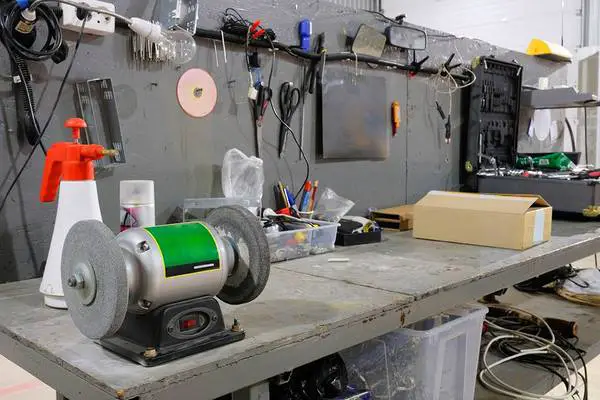
How to Tighten Bench Grinder Wheels and Nuts (4 Easy Steps)
Bench grinders can throw anyone for a loop. It can be confusing when you go to tighten the nuts and wheels on a bench grinder. That is because their nuts and wheels do not tighten in the same way. Most bench grinders have two different directions their nuts and wheels tighten.
How to tighten bench grinder wheels and nuts: It is not hard to tighten bench grinder wheels and nuts. The trick to remember is that the left side of the bench grinder turns counter-clockwise and the right side turns clockwise.
Once you get that pattern down, then it should take you no time at all to tighten the wheels and nuts on a bench grinder. Of course, there are some safety rules you should follow when you do this, so keep reading to find out the best way to tighten the bench grinder’s wheels and nuts.
How to Tighten Grinding Wheels
There are several methods you can use to tighten the grinding wheels on a bench grinder.
The slugger wrench method:
- Hand tighten the screw.
- Roll up a rag and stuff it between the wheel and the tool rest or wheel guard. The wheel should not be able to move.
- Place a wrench over the nut and hit the wrench with a hammer to tighten the nut up further.
- Do not over tighten or you will have wheel issues when you turn the grinder on.
The screwdriver method:
- Hand tighten the nut.
- Take a screwdriver and place it into the slot on the arbor (this will hold the wheel still).
- Place a wrench on the nut and tighten.
- Again, do not over tighten but just make it tight enough. 1/4 turn after hand tightening may be all you will need.
Tip 1: you may use an impact wrench as well. Just keep the settings low.
Tip 2: Instead of using a hammer in the slugger wrench method, you can place the wrench on the nut with its handle close to a table edge or top. Then gently spin the wheel with your hand, letting the wrench handle hit the table and spin the nut. This protects against over-tightening the nut.
How to Tighten Nuts on a Bench Grinder

As we said earlier, some bench grinders have clockwise turning nuts and some have counterclockwise turning nuts. The first key to tightening the nuts on a bench grinder is to make sure you know which nut turns in which direction.
The other key is to make sure the nuts are not much tighter than hand tight when you are done. If you overtighten the nut, you can cause damage to your grinder wheels.
The two wrench method:
Some bench grinder manufacturers recommend that you put a wrench on both nuts on either end of the grinder spindle. You hold one of the wrenches in place. (The left side wrench if you are tightening the right side nut and vice versa). Then tighten the nut that is loose.
The hand method:
Most modern grinders have free-spinning flanges which makes tightening these wheels a bit difficult. What you need to do is:
- Hand tighten the nut, then back turn it about 1/8 of a turn.
- Place a wrench on the nut, then hold the wheel with one hand.
- Then snap the wrench with some force to get the nut into position and be tight enough.
Tip 3: instead of using your hand, you can use a block of wood, cut on an angle. Place the angled portion between the wheel and the tool rest or wheel guard. Make sure it is in there tight enough so the wheel won’t move on you.
Tip 4: Do not put too much pressure on the wheel when you do this. You could damage the wheel and have to replace it.
Safety First

When you are trying to tighten the nuts or grinding wheels on your bench grinder, there are a couple of safety rules you should follow. These rules will protect you and your bench grinder from any harm.
First, before you do any repair work or nut tightening tasks on a bench grinder, make sure you unplug it from its power supply. Don’t just turn it off as you could accidentally bump the switch and turn it back on when you least expect it.
Second, to protect your grinding wheels, bench grinder parts and the bench grinder, make sure the paper washers are properly installed before you tighten the nuts and the wheels.
Tip 5: While it is a method to tighten your bench grinder’s nuts, it is the last option you should consider.
Some Bench Grinder Don’ts
Some of these fall in line with bench grinder safety rules and others are just common sense actions that you should never attempt. There is no particular order to this list:
- Don’t use grinding wheels that have been damaged or dropped. Always do a ring test.
- Don’t force a wheel onto a spindle. If it doesn’t fit, don’t use it.
- Don't alter the arbor hole to make the wheel fit. Get a wheel with an arbor hole that does fit.
- Don’t go past the speed marked on the grinding wheel.
- Don’t grind on the side of the wheel. You grind on the face only.
- Don’t jam your work into the wheel. Apply the proper amount of pressure.
- Don’t grind material that is not meant for the grinding wheel. Plastic, aluminum, wood, and other non-metallic materials should be ground and sanded on on wheels designed to handle those materials.
- Don’t stand in front of a grinder wheel when it is just getting going. Wait till it is at full speed before stepping in front of the wheel.
- Don’t make adjustments to the tool rest, eye guard, wheel guard, and tongue guard while the grinding wheel is spinning.
Some Final Comments
If you stop and think about it, tightening the grinding wheels and nuts on a grinder is very straightforward. A little experience and a little common sense and you should be able to do the job, quickly and correctly.
There are two main keys to remember when tightening the wheels and nuts on a bench grinder. One, do not over tighten the nuts. If you do, you run the risk of damaging your grinding wheel and other bench grinder parts.
Two, do not hit, damage or drop the grinding wheel. They are fragile and can be damaged. Your eyes may not see the damage but it will be there. The above methods should help you avoid these two issues when you have to tighten the wheels and nuts on your bench grinder.

